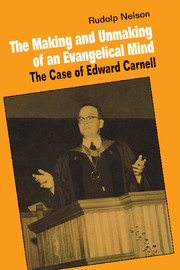I - The narrow ridge and the cognitive bargain
Published online by Cambridge University Press: 10 December 2009
Summary
On a warm December afternoon in 1977, I parked my rented car outside the Alameda County Courthouse in Oakland, California, and sat for a few minutes before keeping my appointment with the County Medical Examiner. I had gone first to the palatial Claremont Hotel, in the hills between Oakland and Berkeley, overlooking the bay. Ten years earlier, the body of Edward Carnell had been found in his room at the hotel, an hour before he was scheduled to deliver a luncheon address to the delegates of a Roman Catholic ecumenical congress. He had been dead since the previous evening. Now I was about to read the coroner's report, which the present Medical Examiner had promised to pull for me.
As I entered his office, I saw that he had been studying the contents of the file. He found, he said, something rather strange about it. I assumed he must be referring to the fact that a theological seminary professor had died in circumstances that raised the question of suicide. But that was not what had caught his attention. He pointed out that whereas the office usually received a half-dozen or so requests for copies of the coroner's report on such cases, this file had an entire second envelope filled with requests, dozens of them, from all over the country. He could not figure it out. It did not take long to solve the mystery. Shuffling quickly through the letters, I recognized some of the names: the nationally famous pastor of a large Southern Baptist church, a right-wing fundamentalist college president, a writer of militant religious pamphlets, an executive of a hyper conservative separatist denomination.
- Type
- Chapter
- Information
- The Making and Unmaking of an Evangelical MindThe Case of Edward Carnell, pp. 3 - 15Publisher: Cambridge University PressPrint publication year: 1988



